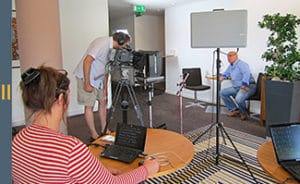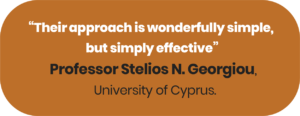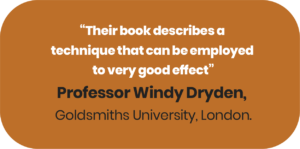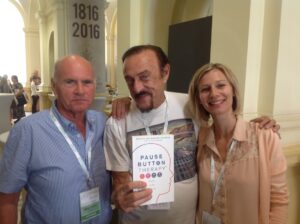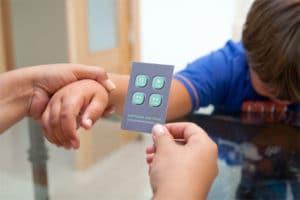Pause Button Therapy News
Read Pause Button Therapy News. On this page you can read brief details of just some of the past media elements achieved for Pause Button Therapy and TactileCBT.
This Morning TV Show
Martin and Marion were interviewed by Philip Schofield and Holly Willoughby on the This Morning TV Show. In July 2018 Martin and Marion made a very short, one-day trip to London to do the interview on This Morning television show.
Good Morning America
Martin and Marion also travelled to New York to appear on a TV special on Good Morning America. The appearance introduced their work across the USA and resulted in clients flying from across America to visit their clinic in Spain.
Psychologies Magazine TactileCBT

If you would like to know more, you can read the complete article.
Daily Mail: Pause Button Therapy News
The Daily Mail featured a story about Katie Drew, a past client of the Elite Clinic in Spain. Katie has lost nearly half her body weight, thanks to PBT. The title of their article was 'The Fat Controller'. This was because she used a mock DVD-style zapper to help her stop and think about what she was eating. She explained how she now 'paused time' and really considered the consequences of her actions. And, as a result, she often made completely different choices. Interestingly, it was also noted that the device and technique had positively changed other areas of her life. Read the full story via this link.
Martin & Marion Shirran filming in the UK
Martin and Marion Shirran flew to the UK to work with a team from Vector TV productions. Whilst there, they filmed a number of short promotional films. These promo videos were for Amazon and Hay House Publishers to promote the new book, Pause Button Therapy. You can also watch a selection of videos which accompany the book on our YouTube channel.
Pause Button Therapy News
Professor Stelios Georgiou invites Gay Jones to Cyprus
Professor Stelios Georgiou, of the University of Cyprus, invited Gay Jones to Cyprus. The purpose of the trip was to train a mixed group of Masters, Doctoral and Post-Doctoral psychology students in the theory and practice of PBT. Representatives from the Ministry of Education, Armed Forces and Psychological support services also attended the event, as well as a Professor from a Greek University. A study into the effectiveness of PBT in changing the behaviour of peer aggressive pupils was also scheduled. Trials of Pause Button Therapy commenced in three Cyprus hospitals to support patients on discharge. Initial feedback has been positive and continues.
Praise for the new PBT book from Professor Windy Dryden of Goldsmiths University, London
Professor Windy Dryden of Goldsmiths University, London, reviewed and praised the Pause Button Therapy book on publication. The book received amazing pre-publication reviews from a wide range of respected authorities. This included Professor Stelios Georgiou, Professor of Educational Psychology at the University of Cyprus.
Pause Button Therapy News
PBT at the First International Time Perspective world conference in Portugal
Pause Button Therapy was the subject of an oral presentation at the First International Time Perspective world conference at the University of Coimbra in Portugal. The Conference showcased cutting edge research in this field and Keynote speakers included Professor Philip Zimbardo of Stanford University. The PBT paper was written by Dr Theano Kalavana.
Pause Button Therapy News
PBT training in Bahrain and Dubai
Dr Leila Edwards invited Martin & Marion Shirran to visit Bahrain and Dubai. The purpose of their visit was to introduce Pause Button Therapy to a group of therapists with the Transformations Institute. As a result, more than fifty delegates attended the two-day course in each location.
Dr Sarah Clarke and Martin and Marion Shirran at Warsaw University
Dr Sarah Clarke, along with Martin and Marion Shirran, delivered a symposium on Pause Button Therapy at the 2nd Annual Time Perspective Conference. The conference took place at Warsaw University in Poland, and Professor Philip Zimbardo, of Stanford University, was the keynote speaker. Interestingly, certainly similarities exist between Pause Button Therapy and the work of professor Zimbardo. He is also the co-author of The Time Paradox and The Time Cure.
Twickenham School in Birmingham, UK trials
UK primary schools in the Midlands evaluated Pause Button Therapy. Gay Jones, Educationalist, co-ordinated a trial of PBT at Twickenham Primary School to help manage the difficult and challenging behaviour of six of their pupils. The children had extreme behavioural and emotional difficulties, and had been unresponsive to all other attempts to modify and manage their behaviour. The trials were highly successful. All of the children were able to grasp the concept quickly and easily. Additionally, parents, teachers, fellow pupils, as well as the children themselves, reported significant improvement in behaviour, emotional regulation and academic performance. You can also read a review of the findings of these trials in detail in the Pause Button Therapy book. (see chapters ten and eleven; Hay House, 2012).
John Taylor, Deputy Headteacher, and Nathan Ross, Head of Pastoral Care, of Twickenham School, both spoke highly of the positive impact that PBT had had on the school. They outlined the benefits the technique had brought for teaching staff, for the children’s peers, for the classroom environment, for the parents and families of the children, as well as for the children themselves. Nathan stated that there had been a “dramatic change” in the behaviour of the children who were using PBT. He added that the school intended to use it more broadly, to help children with milder problems.
John also spoke of the benefits of a technique that was “so simple” to use and administer, yet “so complex” in what it does and how it works. He said that most behavioural modification approaches were complex and time consuming, and therefore difficult to implement. PBT is the reverse, yet remains highly effective.
Pause Button Therapy/TactileCBT is for anyone who’s ever made a mistake in their life and never wants to make one again. It's for anyone who wants to make a change.
Pause Button Therapy/TactileCBT Blog

Contact Us
If you require any additional information about Pause Button Therapy and Tactile CBT, the PBT Cards and Wrist Bands, Work Books, or the new Therapists Training Manual, email us today. We will be pleased to answer any outstanding questions you may have. We look forward to hearing from you soon and maybe helping you change your life, or, of course, assisting you to help others.








